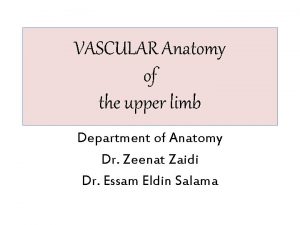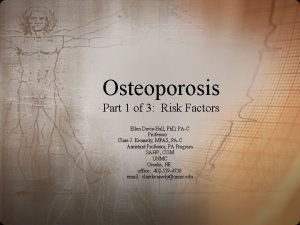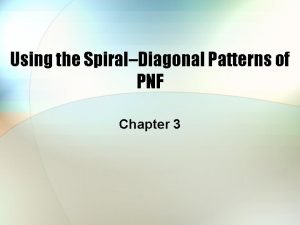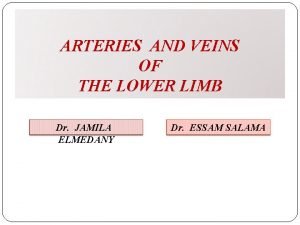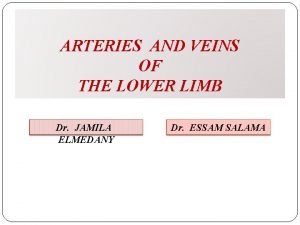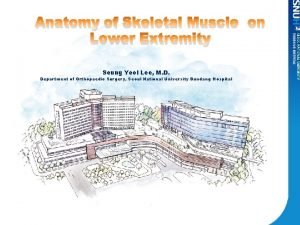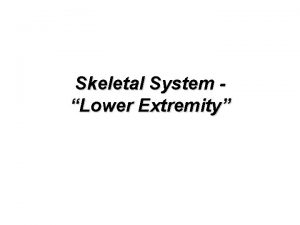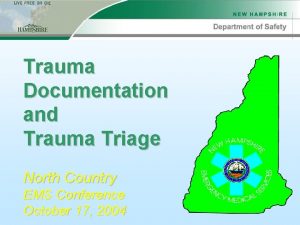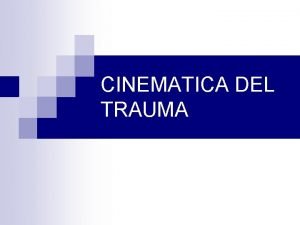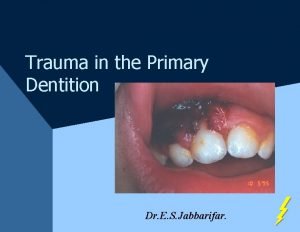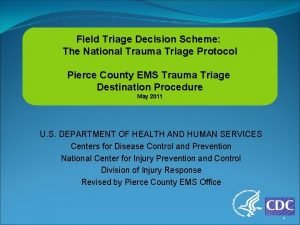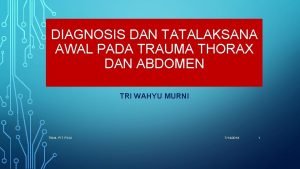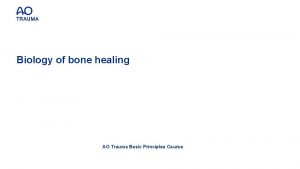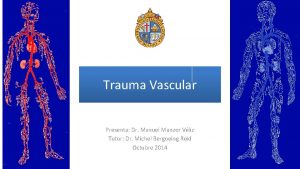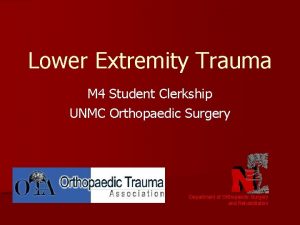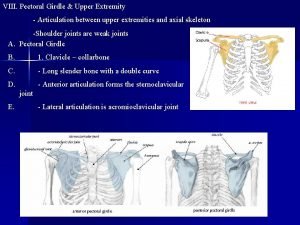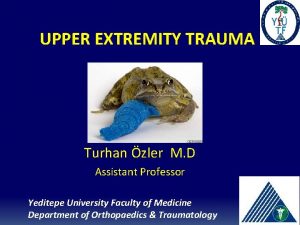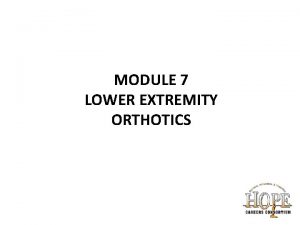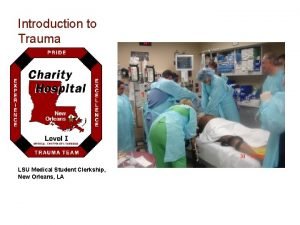Upper Extremity Trauma M 4 Student Clerkship UNMC


















































- Slides: 50

Upper Extremity Trauma M 4 Student Clerkship UNMC Orthopedic Surgery Department of Orthopaedic Surgery and Rehabilitation

Topics n Clavicle n Shoulder Dislocation n Humerus n Elbow n Forearm n Distal Radius

Clavicle Fractures

Clavicle Fractures n Mechanism – – – n Fall onto shoulder (87%) Direct blow (7%) Fall onto outstretched hand (6%) Trimodal distribution The clavicle is the last ossification center to complete (sternal end) at about 22 -25 yo.

Clavicle Fractures n Clinical Evaluation – – – n Inspect and palpate for deformity/abnormal motion Thorough distal neurovascular exam Auscultate the chest for the possibility of lung injury or pneumothorax Radiographic Exam – AP chest radiographs. – Clavicular 45 deg A/P oblique X-rays – Traction pictures may be used as well

Clavicle Fractures n Allman Classification of Clavicle Fractures – Type I Middle Third (80%) – Type II Distal Third (15%) § Differentiate whether ligaments attached to lateral or medial fragment – Type III Medial Third (5%)

Clavicle Fracture n Closed Treatment – Sling immobilization for usually 3 -4 weeks with early ROM encouraged n Operative intervention – – – Fractures with neurovascular injury Fractures with severe associated chest injuries Open fractures Group II, type II fractures Cosmetic reasons, uncontrolled deformity Nonunion

Clavicle Fractures n Associated Injuries – Brachial Plexus Injuries § Contusions most common, penetrating (rare) – Vascular Injury – Rib Fractures – Scapula Fractures – Pneumothorax

Shoulder Dislocations

Shoulder Dislocations n Epidemiology – Anterior: Most common – Posterior: Uncommon, 10%, Think Electrocutions & Seizures – Inferior (Luxatio Erecta): Rare, hyperabduction injury

Shoulder Dislocations n Clinical Evaluation – Examine axillary nerve (deltoid function, not sensation over lateral shoulder) – Examine M/C nerve (biceps function and anterolateral forearm sensation) n Radiographic Evaluation – – True AP shoulder Axillary Lateral Scapular Y Stryker Notch View (Bony Bankart)

Shoulder Dislocations n Anterior Dislocation Recurrence Rate – – – n Age 20: 80 -92% Age 30: 60% > Age 40: 10 -15% Look for Concomitant Injuries – Bony: Bankart, Hill-Sachs Lesion, Glenoid Fracture, Greater Tuberosity Fracture – Soft Tissue: Subscapularis Tear, RCT (older pts with dislocation) – Vascular: Axillary artery injury (older pts with atherosclerosis) – Nerve: Axillary nerve neuropraxia

Shoulder Dislocations n Anterior Dislocation – Traumatic – Atraumatic (Congenital Laxity) – Acquired (Repeated Microtrauma)

Shoulder Dislocations n Posterior Dislocation – Adduction/Flexion/IR at time of injury – Electrocution and Seizures cause overpull of subscapularis and latissimus dorsi – Look for “lightbulb sign” and “vacant glenoid” sign – Reduce with traction and gentle anterior translation (Avoid ER arm Fx)

Shoulder Dislocations n Inferior Dislocations Luxatio Erecta – Hyperabduction injury – Arm presents in a flexed “asking a question” posture – High rate of nerve and vascular injury – Reduce with in-line traction and gentle adduction

Shoulder Dislocation n Treatment – Nonoperative treatment § Closed reduction should be performed after adequate clinical evaluation and appropriate sedation – Reduction Techniques: § Traction/countertraction- Generally used with a sheet wrapped around the patient and one wrapped around the reducer. § Hippocratic technique- Effective for one person. One foot placed across the axillary folds and onto the chest wall then using gentle internal and external rotation with axial traction § Stimson technique- Patient placed prone with the affected extremity allowed to hang free. Gentle traction may be used § Milch Technique- Arm is abducted and externally rotated with thumb pressure applied to the humeral head § Scapular manipulation

Shoulder Dislocations n Postreduction – Post reduction films are a must to confirm the position of the humeral head – Pain control – Immobilization for 7 -10 days then begin progressive ROM n Operative Indications – – Irreducible shoulder (soft tissue interposition) Displaced greater tuberosity fractures Glenoid rim fractures bigger than 5 mm Elective repair for younger patients

Proximal Humerus Fractures


Proximal Humerus Fractures n Epidemiology – Most common fracture of the humerus – Higher incidence in the elderly, thought to be related to osteoporosis – Females 2: 1 greater incidence than males n Mechanism of Injury – Most commonly a fall onto an outstretched arm from standing height – Younger patient typically present after high energy trauma such as MVA

Proximal Humerus Fractures n Clinical Evaluation – Patients typically present with arm held close to chest by contralateral hand. Pain and crepitus detected on palpation – Careful NV exam is essential, particularly with regards to the axillary nerve. Test sensation over the deltoid. Deltoid atony does not necessarily confirm an axillary nerve injury

Proximal Humerus Fractures n Neer Classification – Four parts § Greater and lesser tuberosities, § Humeral shaft § Humeral head – A part is displaced if >1 cm displacement or >45 degrees of angulation is seen

Proximal Humerus Fractures n Treatment – Minimally displaced fractures- Sling immobilization, early motion – Two-part fractures§ Anatomic neck fractures likely require ORIF. High incidence of osteonecrosis § Surgical neck fractures that are minimally displaced can be treated conservatively. Displacement usually requires ORIF – Three-part fractures § Due to disruption of opposing muscle forces, these are unstable so closed treatment is difficult. Displacement requires ORIF. – Four-part fractures § In general for displacement or unstable injuries ORIF in the young and hemiarthroplasty in the elderly and those with severe comminution. High rate of AVN (13 -34%)

Humeral Shaft Fractures

Humeral Shaft Fractures n Mechanism of Injury – – – Direct trauma is the most common especially MVA Indirect trauma such as fall on an outstretched hand Fracture pattern depends on stress applied § § Compressive- proximal or distal humerus Bending- transverse fracture of the shaft Torsional- spiral fracture of the shaft Torsion and bending- oblique fracture usually associated with a butterfly fragment

Humeral Shaft Fractures n Clinical evaluation – Thorough history and physical – Patients typically present with pain, swelling, and deformity of the upper arm – Careful NV exam important as the radial nerve is in close proximity to the humerus and can be injured

Humeral Shaft Fractures n Radiographic evaluation – AP and lateral views of the humerus – Traction radiographs may be indicated for hard to classify secondary to severe displacement or a lot of comminution

Humeral Shaft Fractures n Conservative Treatment – Goal of treatment is to establish union with acceptable alignment – >90% of humeral shaft fractures heal with nonsurgical management § 20 degrees of anterior angulation, 30 degrees of varus angulation and up to 3 cm of shortening are acceptable § Most treatment begins with application of a coaptation spint or a hanging arm cast followed by placement of a fracture brace

Humeral Shaft Fractures n Treatment – Operative Treatment § Indications for operative treatment include inadequate reduction, nonunion, associated injuries, open fractures, segmental fractures, associated vascular or nerve injuries § Most commonly treated with plates and screws but also IM nails

Humeral Shaft Fractures n Holstein-Lewis Fractures – Distal 1/3 fractures – May entrap or lacerate radial nerve as the fracture passes through the intermuscular septum

Elbow Fracture/Dislocations

Elbow Dislocations n Epidemiology n Mechanism of injury – Accounts for 11 -28% of injuries to the elbow – Posterior dislocations most common – Highest incidence in the young 10 -20 years and usually sports injuries – Most commonly due to fall on outstretched hand or elbow resulting in force to unlock the olecranon from the trochlea – Posterior dislocation following hyperextension, valgus stress, arm abduction, and forearm supination – Anterior dislocation ensuing from direct force to the posterior forearm with elbow flexed

Elbow Dislocations n Clinical Evaluation – Patients typically present guarding the injured extremity – Usually has gross deformity and swelling – Careful NV exam in important and should be done prior to radiographs or manipulation – Repeat after reduction n Radiographic Evaluation – AP and lateral elbow films should be obtained both pre and post reduction – Careful examination for associated fractures

Elbow Fracture/Dislocations n Treatment – Posterior Dislocation § Closed reduction under sedation § Reduction should be performed with the elbow flexed while providing distal traction § Post reduction management includes a posterior splint with the elbow at 90 degrees § Open reduciton for severe soft tissue injuries or bony entrapment – Anterior Dislocation § Closed reduction under sedation § Distal traction to the flexed forearm followed by dorsally direct pressure on the volar forearm with anterior pressure on the humerus

Elbow Dislocations n Associated injuries – Radial head fx (5 -11%) – Treatment § Type I- Conservative § Type II/III- Attempt ORIF vs. radial head replacement § No role for solely excision of radial head in 2006.

Elbow Dislocations n Associated injuries – Coronoid process fractures (5 -10%)

Elbow Dislocations n Associated injuries – Medial or lateral epicondylar fx (12 -34%)

Elbow Dislocations n Instability Scale – Type I § Posterolateral rotary instability, lateral ulnar collateral ligament disrupted – Type II § Perched condyles, varus instability, ant and post capsule disrupted – Type III § A: posterior dislocation with valgus instability, medial collateral ligament disruption § B: posterior dislocation, grossly unstable, lateral, medial, anterior, and posterior disruption

Forearm Fractures

Forearm Fractures n Epidemiology – Highest ratio of open to closed than any other fracture except the tibia – More common in males than females, most likely secondary mva, contact sports, altercations, and falls n Mechanism of Injury – Commonly associated with mva, direct trauma missile projectiles, and falls

Forearm Fractures n Clinical Evaluation n Radiographic Evaluation – Patients typically present with gross deformity of the forearm and with pain, swelling, and loss of function at the hand – Careful exam is essential, with specific assessment of radial, ulnar, and median nerves and radial and ulnar pulses – Tense compartments, unremitting pain, and pain with passive motion should raise suspicion for compartment syndrome – AP and lateral radiographs of the forearm – Don’t forget to examine and x-ray the elbow and wrist

Forearm Fractures n Ulna Fractures – These include nightstick and Monteggia fractures – Monteggia denotes a fracture of the proximal ulna with an associated radial head dislocation § Monteggia fractures classification- Bado § Type I- Anterior Dislocation of the radial head with fracture of ulna at any level- produced by forced pronation § Type II- Posterior/posterolateral dislocation of the radial head- produced by axial loading with the forearm flexed § Type III- Lateral/anterolateral dislocation of the radial head with fracture of the ulnar metaphysis- forced abduction of the elbow § Type IV- anterior dislocation of the radial head with fracture of radius and ulna at the same level- forced pronation with radial shaft failure

Forearm Fractures n Radial Diaphysis Fractures – Fractures of the proximal two-thirds can be considered truly isolated – Galeazzi or Piedmont fractures refer to fracture of the radius with disruption of the distal radial ulnar joint – A reverse Galeazzi denotes a fracture of the distal ulna with disruption of radioulnar joint n Mechanism – Usually caused by direct or indirect trauma, such as fall onto outstretched hand – Galeazzi fractures may result from direct trauma to the wrist, typically on the dorsolateral aspect, or fall onto outstretched hand with pronation – Reverse Galeazzi results from fall with hand in supination

Distal Radius Fractures

Distal Radius Fractures n Epidemiology – Most common fractures of the upper extremity – Common in younger and older patients. Usually a result of direct trauma such as fall on out stretched hand – Increasing incidence due to aging population n Mechanism of Injury – Most commonly a fall on an outstretched extremity with the wrist in dorsiflexion – High energy injuries may result in significantly displaced, highly unstable fractures

Distal Radius Fractures n Clinical Evaluation – Patients typically present with gross deformity of the wrist with variable displacement of the hand in relation to the wrist. Typically swollen with painful ROM – Ipsilateral shoulder and elbow must be examined – NV exam including specifically median nerve for acute carpal tunnel compression syndrome

Radiographic Evaluation n 3 view of the wrist including AP, Lat, and Oblique – Normal Relationships 23 Deg 11 mm

Distal Radius Fractures n Eponyms – Colles Fracture § Combination of intra and extra articular fractures of the distal radius with dorsal angulation (apex volar), dorsal displacement, radial shift, and radial shortenting § Most common distal radius fracture caused by fall on outstretched hand – Smith Fracture (Reverse Colles) § Fracture with volar angulation (apex dorsal) from a fall on a flexed wrist – Barton Fracture § Fracture with dorsal or volar rim displaced with the hand carpus – Radial Styloid Fracture (Chauffeur Fracture) § Avulsion fracture with extrinsic ligaments attached to the fragment § Mechanism of injury is compression of the scaphoid against the styloid

Distal Radius Fractures n Treatment – Displaced fractures require and attempt at reduction. § Hematoma block-10 ccs of lidocaine or a mix of lidocaine and marcaine in the fracture site § Hang the wrist in fingertraps with a traction weight § Reproduce the fracture mechanism and reduce the fracture § Place in sugar tong splint – Operative Management § For the treatment of intraarticular, unstable, malreduced fractures. § As always, open fractures must go to the OR.

 Lcme clerkship requirements
Lcme clerkship requirements East bay hand & upper extremity
East bay hand & upper extremity Axillary artery
Axillary artery The biomechanics of the human upper extremity
The biomechanics of the human upper extremity Pnf patterns upper extremity
Pnf patterns upper extremity Grant's atlas
Grant's atlas Open chain exercises
Open chain exercises Unmc obgyn residents
Unmc obgyn residents Unmc redcap
Unmc redcap Dr ellen davis
Dr ellen davis Unmc obgyn residents
Unmc obgyn residents D2 extension lower extremity
D2 extension lower extremity Dorsal arch veins
Dorsal arch veins Stretcher lifting techniques
Stretcher lifting techniques Left lower extremity
Left lower extremity Dorsalis pedis artery pulse location
Dorsalis pedis artery pulse location Spasticity definition
Spasticity definition Jacket restraints for pediatrics
Jacket restraints for pediatrics Extremity
Extremity Lower extremity appendicular skeleton
Lower extremity appendicular skeleton Dorsalis pedis artery pulse location
Dorsalis pedis artery pulse location Lower extremity muscles
Lower extremity muscles Hospital wristband color meaning
Hospital wristband color meaning Your last weekend
Your last weekend National student clearinghouse student tracker
National student clearinghouse student tracker Sls moe
Sls moe What did you do over the weekend
What did you do over the weekend Freckle.com.login
Freckle.com.login National student clearinghouse student tracker
National student clearinghouse student tracker Teacher
Teacher Class maths student student1 class student string name
Class maths student student1 class student string name Dellucci helene
Dellucci helene Miemss trauma decision tree
Miemss trauma decision tree Kampala trauma score
Kampala trauma score Revised trauma score
Revised trauma score Stan and ute lawrence
Stan and ute lawrence Xabcd trauma
Xabcd trauma Macam macam trauma thorax
Macam macam trauma thorax Cinematica
Cinematica Dental trauma
Dental trauma Incest trauma centar
Incest trauma centar Trauma
Trauma National trauma triage protocol
National trauma triage protocol Unfavourable sequelae of malocclusion
Unfavourable sequelae of malocclusion Hematothorax
Hematothorax Childhood trauma
Childhood trauma Ao trauma
Ao trauma Labelling
Labelling Manuel manzor veliz
Manuel manzor veliz Cinematica del trauma
Cinematica del trauma Trauma made simple
Trauma made simple


